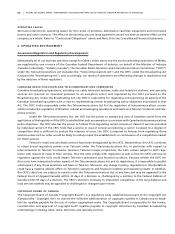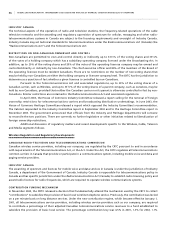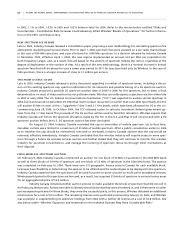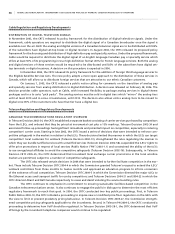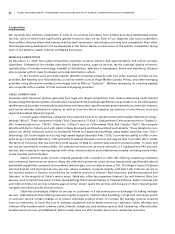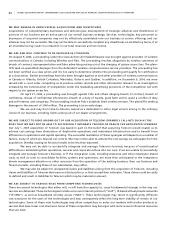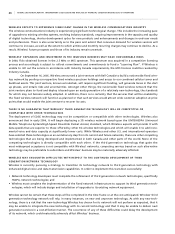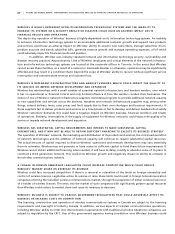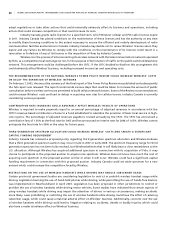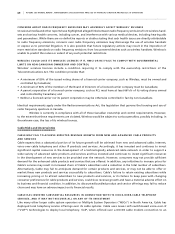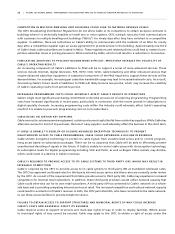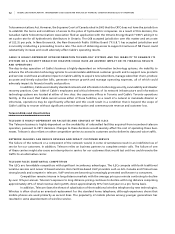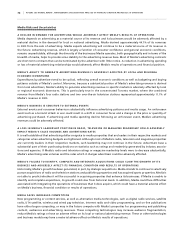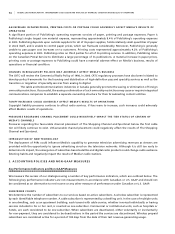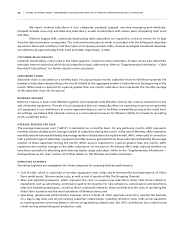Rogers 2005 Annual Report Download - page 69
Download and view the complete annual report
Please find page 69 of the 2005 Rogers annual report below. You can navigate through the pages in the report by either clicking on the pages listed below, or by using the keyword search tool below to find specific information within the annual report.
65 ROGERS 2005 ANNUAL REPORT . MANAGEMENT’S DISCUSSION AND ANALYSIS OF FINANCIAL CONDITION AND RESULTS OF OPERATIONS
Wireless Risks and Uncertainties
WI R E LE S S F AC E S S U BS T AN T I AL CO M PE T I TI O N
The Canadian wireless communications industry is highly-competitive. In the wireless voice and data market, Wireless
competes primarily with two other wireless service providers and may in the future compete with other companies,
including resellers, such as Virgin Mobile Canada, and Primus. Potential users of wireless voice and data systems may
find their communications needs satisfied by other current or developing technologies, such as WiFi, “hotspots” or
trunk radio systems, which have the technical capability to handle mobile telephone calls. Wireless also competes with
rivals for dealers and retail distribution outlets. There can be no assurance that its current or future competitors will not
provide services comparable or superior to those Wireless provides, or at lower prices, adapt more quickly to evolving
industry trends or changing market requirements, enter the market in which Wireless operates, or introduce competing
services. Any of these factors could reduce Wireless’ market share or decrease its revenue.
PR I C E C OM P ET I T IO N C O UL D AD V ER S EL Y AF F EC T WI R EL E SS ’ CH U RN RA T E A N D R EV E NUE GR O WT H
Aggressive pricing by industry participants in previous years caused significant reductions in Canadian wireless com-
munications pricing. Wireless believes that competitive pricing is a factor in causing churn. Wireless cannot predict the
extent of further price competition and customer churn in the future, but it anticipates some ongoing re-pricing of
its existing subscriber base as lower pricing offered to attract new customers is extended to or requested by existing
customers. In addition, as wireless penetration of the population deepens, new wireless customers may generate lower
average monthly revenues than those from its existing customers, which could slow revenue growth.
TH E IM P LE M EN T A TI O N O F W I RE L ES S N U M BE R P O RTA B IL I TY IN C AN A DA COU L D C RE A TE S IG N IF I C AN T C O ST S FO R
WI R E LE S S A ND I NC R EA S E C H UR N
Over the past several years, certain countries in Europe and Asia have mandated WNP. In 2004, the U.S. wireless industry
also implemented WNP. WNP involves porting wireless phone numbers to other wireless companies, but can also involve
porting phone numbers between wireline and wireless companies. The implementation of WNP systems and capabili-
ties imposes significant costs on the carriers in a country. The federal budget was released on February 23, 2005. In the
budget speech, the government stated that it would request the CRTC to move expeditiously to implement WNP. In a
letter dated March 18, 2005 to the CRTC, the Minister of Industry noted that WNP includes wireless-to-wireless, wireline-
to-wireless and wireless-to-wireline number portability.
On April 21, 2005, the Canadian Wireless Telecommunications Association (“CWTA”) announced that Canada’s
wireless carriers, including Wireless, agreed to implement number portability in Canada, and have begun the planning
efforts required to achieve this result.
The CWTA contracted with an independent consultant to complete a comprehensive project plan outlining
specific milestones for this process. The plan was completed and released on September 12, 2005. The CWTA and the
wireless carriers endorsed the start date of September 12, 2007 as outlined in the consultant’s report. On September
16, 2005, the CRTC released a Public Notice requesting comments on a number of regulatory issues, as well as the imple-
mentation date of September 2007. This was followed up on September 23, 2005 with a request to consider a phased
approach. On December 20, 2005, the CRTC mandated that WNP becomes available in March 2007. This implementation
of WNP will require carriers, including Wireless, to incur implementation costs that could be significant and could cause
an increase in churn among Canadian wireless carriers.
WI R E LE S S M AY F AI L T O A C H IE V E E XP E C TE D R E VEN U E G RO W TH F RO M N E W A N D A DV A NCE D W I RE L E SS SE R VI C E S
Wireless expects that a substantial portion of its future revenue growth will be achieved from new and advanced wire-
less voice and data transmission services. Accordingly, Wireless has invested and continues to invest significant capital
resources in the development of its GSM/GPRS/EDGE network in order to offer these services. However, there may not be
sufficient consumer demand for these advanced wireless services. Alternatively, Wireless may fail to anticipate or satisfy
demand for certain products and services, or may not be able to offer or market these new products and services success-
fully to subscribers. The failure to attract subscribers to new products and services, or failure to keep pace with changing
consumer preferences for wireless products and services, would slow revenue growth and have a material adverse effect
on Wireless’ business and financial condition.


